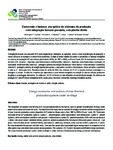Please use this identifier to cite or link to this item:
http://www.alice.cnptia.embrapa.br/alice/handle/doc/978381| Title: | Conversão e balanço energético de sistemas de produção com integração lavoura-pecuária, sob plantio direto. |
| Authors: | SANTOS, H. P. dos  FONTANELI, R. S.   SPERA, S. T.   DREON, G.   |
| Affiliation: | HENRIQUE PEREIRA DOS SANTOS, CNPT; RENATO SERENA FONTANELI, CNPT; SILVIO TULIO SPERA, CPAMT; Geizon Dreon, UPF. |
| Date Issued: | 2013 |
| Citation: | Agrária, v. 8, n. 1, p. 1-7, jan./mar., 2013 |
| Pages: | 1-7 |
| Description: | A integração lavoura com pecuária (ILP) pode proporcionar vantagens ao agricultor, como a maior diversificação de produção, o menor consumo de energia e o menor risco econômico. O objetivo deste trabalho foi avaliar a conversão e o balanço energético em sistema de produção ILP, sob sistema plantio direto (SPD), de 1997 a 2008, em Passo Fundo, RS. Os tratamentos consistiram de cinco ILPs: sistema I - trigo/soja, aveia branca/soja e ervilhaca/milho; sistema II - trigo/soja, aveia branca/soja e pastagem de aveia preta +ervilhaca/milho; sistema III - pastagens perenes da estação fria (festuca + trevo branco + trevo vermelho + cornichão); sistema IV - pastagens perenes da estação quente (pensacola + aveia preta + azevém + trevo branco + trevo vermelho + cornichão) e sistema V - alfafa para feno. Ressalta-se que no verão de 2002, nos sistemas III, IV e V a lavoura retornou à pastagem e a pastagem à lavoura. O milho foi a espécie que apresentou o maior retorno energético em relação às demais culturas produtoras de grãos e as pastagens de inverno. Os sistemas I, III, IV e V foram os mais eficientes na conversão da energia. Os sistemas de produção ILP sob SPD foram energeticamente viáveis, pois, mostraram conversão e balanço energético positivo. The integration of livestock and farming (ILP) may provide benefits to the farmer, such as greater diversification of crops, lower power consumption and lower risk costs. The objective of this study was to evaluate the energy conversion and the energy balance of crop -livestock production system integration (ILP) under no-tillage system, from 1997 to 2008 in Passo Fundo, RS. Treatments consisted of five ILP production systems: system I - wheat/soybean, white oats/soybean and vetches/corn; system II - wheat/ soybean, white oats/soybean and black oats pasture + vetches/maize; system III - perennial pastures of the cold season (festuca + white + red clover clover + birdsfoot trefoil); system IV- perennial pasture of the hot season (Pensacola grass + black oat + rye grass + red and white clover + birdsfoot trefoil); and system V- alfalfa hay. However, in the summer of 2002, systems III, IV and V, the crop returned to the pasture and vice-versa. Corn was the specie which presented higher energy return in comparison to the other grain crops and winter and summer annual pastures. The systems I, III, IV and V showed most efficient energy conversion. The crops-livestock production system under no tillage is viable, and also showed positive energy conversion and balance. |
| NAL Thesaurus: | crop rotation |
| Keywords: | Balanço Energético Pastagens de inverno e verão Rotação de Culturas Winter and Summer Annual Pastures Sistemas de Produção Sistemas Integrados |
| ISSN: | 1981-1160 |
| DOI: | http://dx.doi.org/10.5039/agraria.v8i1a1392 |
| Type of Material: | Artigo de periódico |
| Access: | openAccess |
| Appears in Collections: | Artigo em periódico indexado (CPAMT)  |
Files in This Item:
| File | Description | Size | Format | |
|---|---|---|---|---|
| cpamtspera198111602013b.pdf | 1.3 MB | Adobe PDF |  View/Open |









